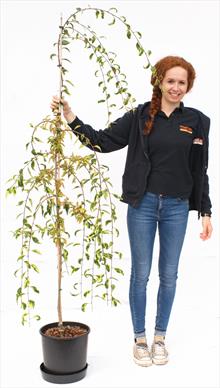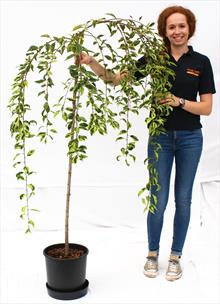Frilly FrockTM
PrunusFrilly Frock is a small flowering cherry tree with a strongly weeping habit - the dense foliage trails to the ground, hiding the stem almost entirely.
An unusual feature of this pretty tree is the variegated leaves, which have a green centres - the effect is not noticeable when the leaves emerge in the spring but becomes more prominent over the summer.
The blossom is pale pink, and borne in profusion. In the autumn the leaves turn orange, red and gold.
We sometimes have "top-worked" forms of Frilly Frock, where the graft is at the top of a length of clear stem rather than at the bottom. This accentuates the weeping habit and gives a "lollypop" effect while keeping the tree fairly small. The mature height of these trees is usually not much taller than the graft height, so a 120cm top-worked tree will perhaps reach 130cm - 140cm in the longer term.
In short, Frilly Frock is an excellent choice for the smaller garden if you want a compact weeping tree with spring and autumn interest.
Frilly Frock flowering cherry trees for sale

All our pot-grown trees are grown for us to our specification by the Frank P Matthews nursery.
All pot-grown trees are suitable for planting out in the garden, some are suitable for growing in containers.
11-year bare-root
tree
£46.50
Small size (1.5m-2.5m after 10 years)
Out of stock
Sorry we have sold out for this season
22-year pot-grown
tree
£75.00
Grown for us by Frank P Matthews nursery
In a 12L pot
Small size (1.5m-2.5m after 10 years)
Out of stock
Sorry we have sold out for this season
How to grow
Frilly Frock is sometimes classified in the species Prunus incisa, also known as the Fuji Cherry because they are found growing wild on the slopes of the famous Mt. Fuji volcano in Japan.
As you might expect, these small compact trees are very hardy and easy to grow.
They are also well-suited to growing in a patio container or planter. Feed the tree in early spring, and give it a medium-hard prune after flowering to maintain the size (this also helps maintain the variegation).
History
Frilly Frock was discovered and named in 2005 at the Frank P Matthews nursery in the west Midlands. It is a sport (natural bud mutation) of Prunus Snow Showers, distinguished from that variety by its characteristic variegated leaves.
Frilly Frock characteristics
- Gardening skillBeginner
- Attractive featuresAttractive flowersAutumn foliage colourVariegated foliage
- Growth habitWeeping
- Height after 10 years1.5m-2.5m / 5ft-8ft
- Growth rateAverage
- Flower colourPink - light
- Flower formSingle flower (5-8 petals)
- Flowering monthMarchApril
- Leaf colour - autumnMultiple tints
- Country of originJapan
- Annual cycleDeciduous
Similar varieties
Prunus incisaKojo-no-maiAn excellent small compact blossom tree, featuring a mass of small white flowers, and good autumn colours.
Prunus incisaMikinoriMikinori is a classic early-flowering Fuji cherry tree, with red autumn leaf colours.
Prunus incisaPendulaA small graceful weeping Fuji cherry, with small single white flowers.
Prunus incisaPraecoxA small and hardy winter-flowering cherry, ideal for winter colour and small gardens.
Prunus incisa x speciosaSnow GooseA small upright flowering cherry tree with particularly large single white flowers.
PrunusSnow ShowersSnow Showers is a compact slow-growing flowering cherry, with long weeping branches and a mass of white single flowers.
What will it look like?
Illustrative examples of 12L pot-grown trees of this variety as supplied.
Approximate girth: 6/8cm. We try to keep all pot-grown trees down to about 1.5m as supplied, but some may be larger.
Trees should reach their mature height after about 10 or more years.
We may also have 1-year bare-root trees of this variety - they are not shown here.
 Prunus Frilly Frock tree
Prunus Frilly Frock tree Prunus Frilly Frock top-worked
Prunus Frilly Frock top-worked
How to choose a flowering cherry tree
We list more than 70 different flowering cherry trees. Choosing can be difficult! Our article explaining the different characteristics of flowering cherries might help narrow down the selection.
 Over 400 varieties of flowering cherries, crab apples, rowans and other ornamental trees.
Over 400 varieties of flowering cherries, crab apples, rowans and other ornamental trees.